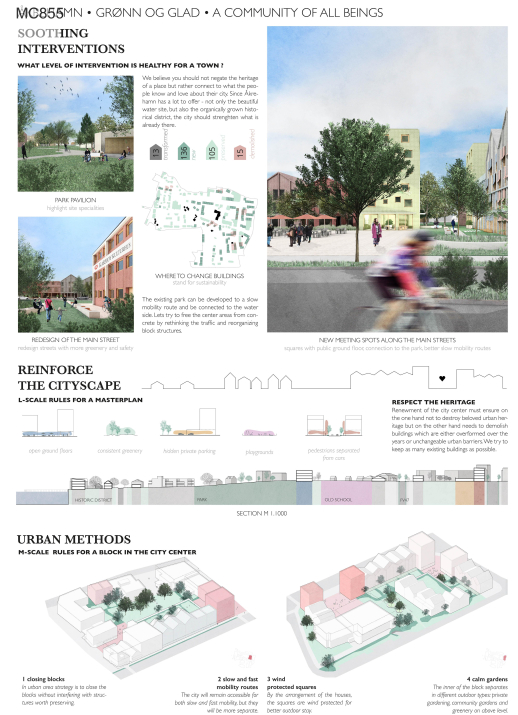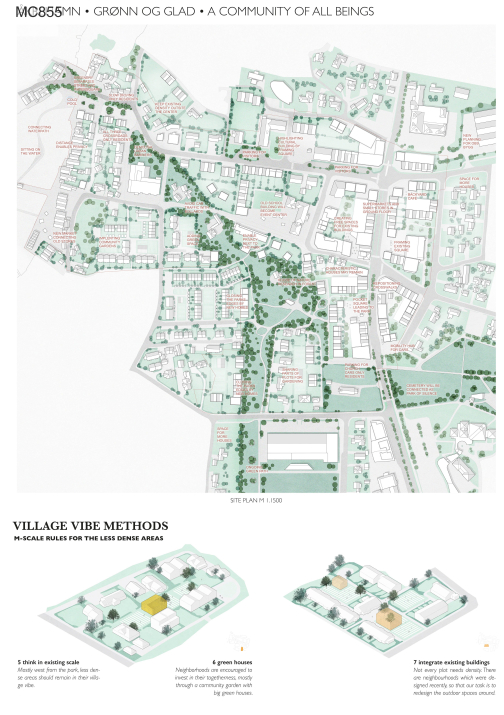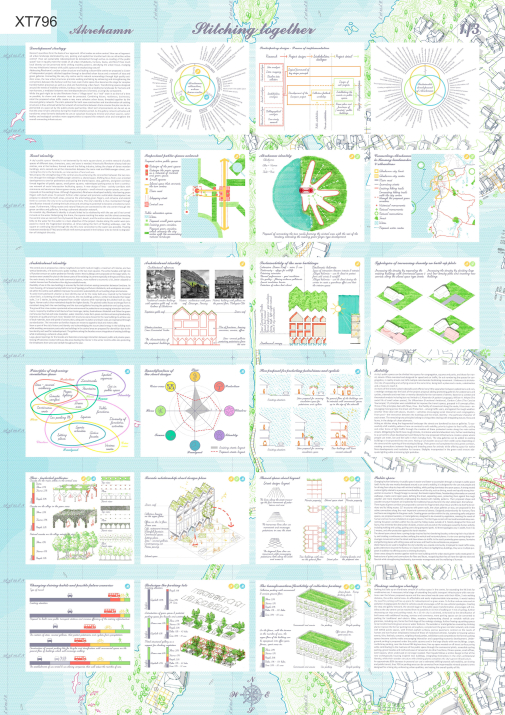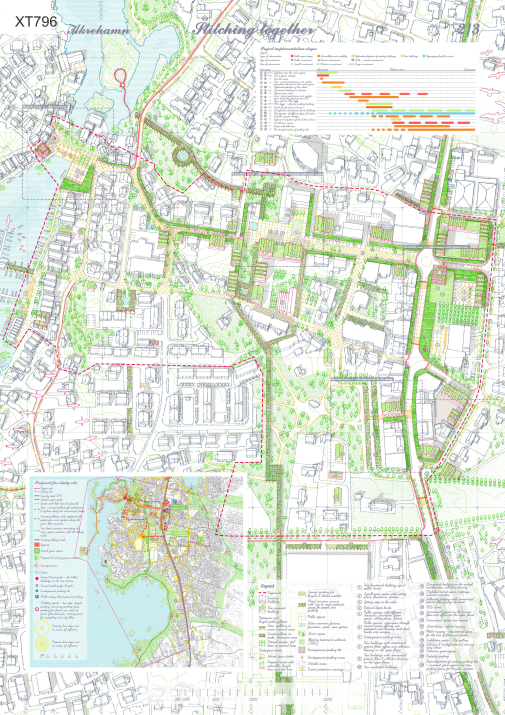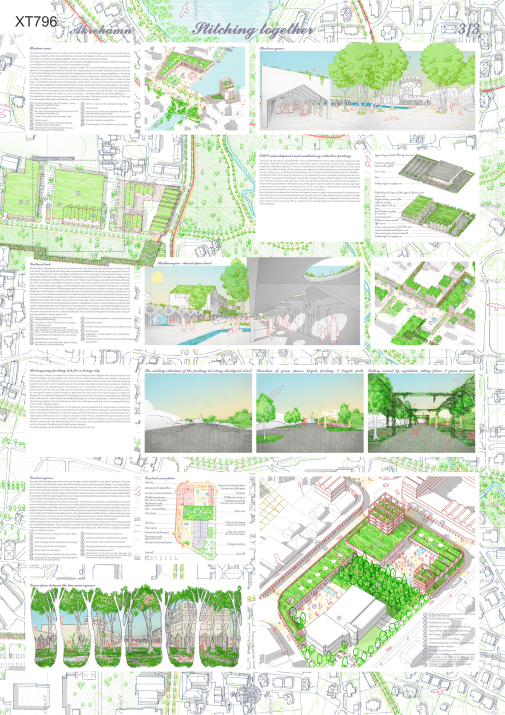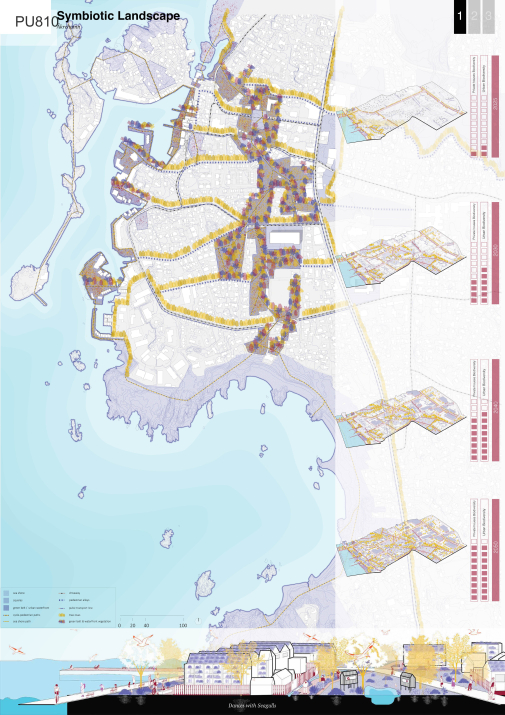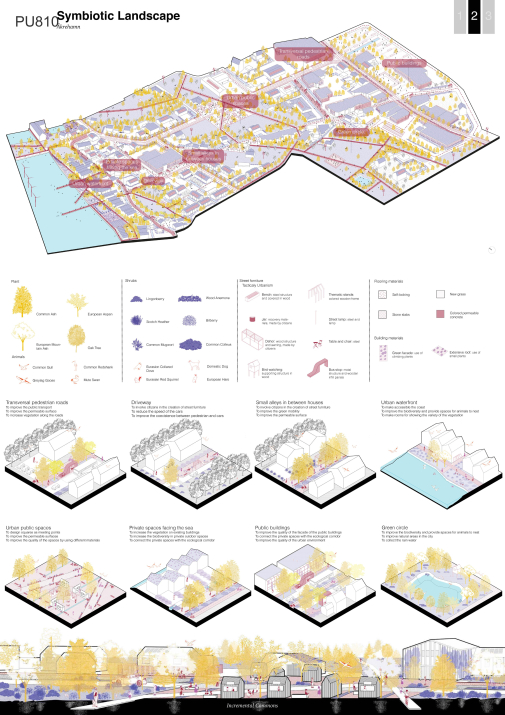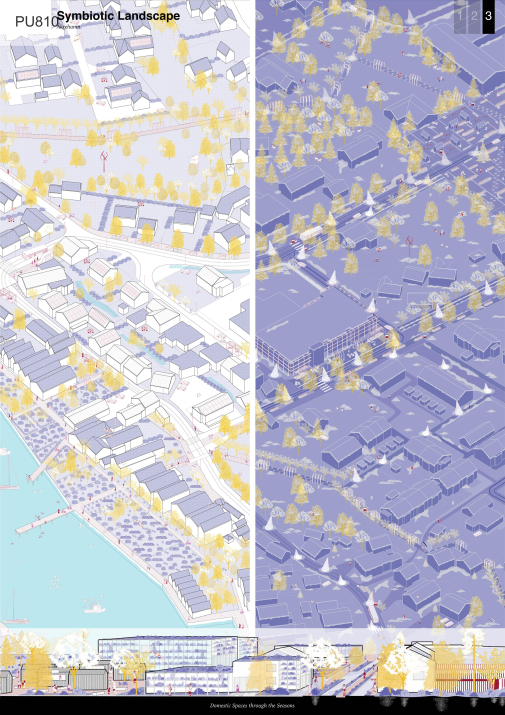See the winning entries in Åkrehamn

"Grønn og glad" by won the competition in Åkrehamn
General Remarks by the jury
The main tasks outlined by the competition brief were to create an attractive city center, showing the potential for both new construction and renovation as well as creating high-quality outdoor areas in an overarching urban plan. The jury saw the key challenge to be giving coherence and vibrancy to the existing, dispersed town structure.
Having viewed all of the competition proposals, it is clear that mending the urban fabric, creating conceivable city spaces and finding the identity of Åkrehamn has not been easy. Perhaps the proposals show us that there is not ONE solution that does the trick. And maybe even more controversially, that architecture alone cannot answer the task.
Looking at the aerial photos of Åkra, seeing the town center – and the study site around it with a beach, a harbor, fields and sea, the city center looks empty. Densely knit suburban fabric surrounds the less dense town center. The only real dense urban place within the town center is the old harbor.
The jury has thus favored proposals that aim to solve the city on more than one level in a balanced way; successful proposals have combined different scales or worked simultaneously on town blocks, streets and the landscape. The most interesting proposals managed to create a clear vision of how to sensibly connect the harbor with the ‘new’ city center. These proposals also linked the urban fabric to its underlying and surrounding landscape. Finally, successful proposals had something to help get local stakeholders on board, whether that was a well-communicated theme in the proposal or a sense of excitement about the place.
So, what is needed to turn the competition proposals into successful planning? Is it an overall conceptual plan, a toolbox, a set of city-building rules or a very detailed and prescriptive plan covering all areas of the city center? Or is it something that can inspire the various stakeholders to join the process? Åkrehamn needs all of the above in a good mix to create the necessary city hierarchy and participation. It is the clear recommendation from the jury that the winning proposal work together with the 2 runners up to form a coherent strategy on many scales for the renewal of Åkrahamn.
Download the full report for feedback on all projects
Team
Karla Reuter (DE), architect
Tobias Herr (DE), architect
Ben Thullesen (DE), architect
Jury remarks
On the large scale, the project “Grønn og Glad – A Community of All Beings” proposes a clear strategy to generate an urban centrality for Åkrehamn by developing and extending the existing North-South green belt into a clearly defined central spine. This structure, reaching all the way from the beach to the old harbor, connects the natural qualities that surround Åkra with a row of existing programs in the center to create a common narrative. Although some specific situations proposed in this green belt do not seem easily realizable, the jury sees in it a narrative clear and strong enough to lead its gradual development, capable of giving Åkrehamn from the very moment an image of its missing centre.
Beside this big move, the proposal identifies the urban block as the key scale, in which this rather dispersed urban situation has a chance to become an urban structure. Subsequently, it proposes a set of tools to reulate a transformation of the blocks, both in their role of generating spatially clear outsides and programmed living insides. The Jury sees in the idea of redefining Åkrehamn by the reinforcement of its urban cells a credible response to the informal dynamics, which seem to have been the motor of this area’s urban development up to today. At the same time, it opens possibilities for the public actors –the municipality– to get integrated with a leading role in this complex process.
The scale of the proposed buildings are successful both at keeping with Åkras architectural identity while showing how carefully placed taller buildings successfully can contribute to reinforcing urban qualities.
The jury has observed with some skepticism the over-dimensioning of public spaces in the project, especially in the number of urban squares. On the one hand, they do not seem credible with an urban density and intensity like Åkrehamn’s. On the other hand, they would reduce the intensity of both the green centrality and the greater definition of urban space created by the new blocks.
Finally, the Jury acknowledges the emphasis placed by the project on using and enhancing what is already there, what increases its ecological, social and economic resilience, and therefore its credibility.
Team:
Ana-Maria Branea (RO), architect urbanist
Marius Stelian Gaman (RO), architect urbanist
Anamaria Bujanca (RO), architect
Romina Popescu (RO), architect
Alexandru Mihailescu (RO), architect
Jury remarks:
Stitching together provides Åkrehamn with a wealth of suggestions. Some of the ideas are provocative and exaggerated, obscuring the foundations of the proposal and making it difficult to communicate to stakeholders. Nevertheless, the proposal is built on well-thought-out and presented master-plan basics. It emanates excitement and optimism about the town, which might serve Åkrehamn well in the upcoming planning work.
The most prominent ideas are arcades and stoae that Stitching together proposes to unify the town centre, bestow it with identity, and provide shelter from the elements. The amount of arcades is overblown, and their implementation would be problematic in several ways. However, in places, stoaes could work as intended, giving integrity and intimacy to shapeless, oversized squares or undefined streets.
Most successfully, Stitching together demonstrates how to turn the backyard-like area between Rådhusvegen and the old road to the harbour, Åkravegen, into legible streets and town blocks. The proposal has placed infill buildings to form compact blocks and complemented that with a boldly extensive redesign of the streets and revamp of the surface parking. Central city blocks of Åkrehamn take shape.
Another great goal of Stitching together is to extend access to the waterside of the harbour. A key element is a pier in front of the private waterfront plots. While not an easy solution to implement, the pier could be transformative for the harbour in combination with other public space improvements proposed by the water.
Finally, the tentative schedule of the various projects provides insight into a strategy to revitalize and transform Åkrehamn, giving the vision a much-needed time perspective and priority.
Team:
Filippo Fiandanese (IT), architect
Silvia Lanteri (IT), architect urbanist
Maicol Negrello (IT), landscape architect
Alessia Carena (IT), architect
Federico Demichelis (IT), architect
Marthe Van Endert (BE), architect
Sara Barera (IT), architect
Cara Geldenhuys (ZA), architect
Jury Remarks:
Symbiotic Landscape focuses on a series of elements that need to be connected and proposes a phased project through various steps to transform the landscape. Highlighting the significance of a north-south urban waterfront and a corresponding green belt in the city center, the project links these features through a network of west-east transversal streets. A masterplan is composed using plants, shrubs and street furniture as tools for tactical urbanism that adds a consistent scale to the street network.
The jury thinks Symbiotic Landscape is an interesting proposal that uses green structures as tools for transforming and revitalizing the urban fabric of Åkra. The jury is impressed with the solid concept and boldness of this project. It is a fully sustainable project, presented in stunningly beautiful graphics. It triggers the viewer's visions and imagination of what Åkrehamn could become.
In the jury's opinion, the proposal to develop along the waterfront is important, although the landfilling might be unnecessary. The jury also questions the economic feasibility, as well as the challenging growing conditions for trees, due to heavy weather and constant wind. It would be interesting to see the urban scheme of waterfront, green belt, and transversal streets clarified and strengthened through a strategy that is more varied and contains a wider array of tools and instruments than only trees, shrubs, and furniture.
This proposal shows a new meaning of densification, through trees and vegetation, and is a completely new way to address the situation of Åkra, and although it is not proposing new buildings, it structures and provides identity to the city in an innovative way.
